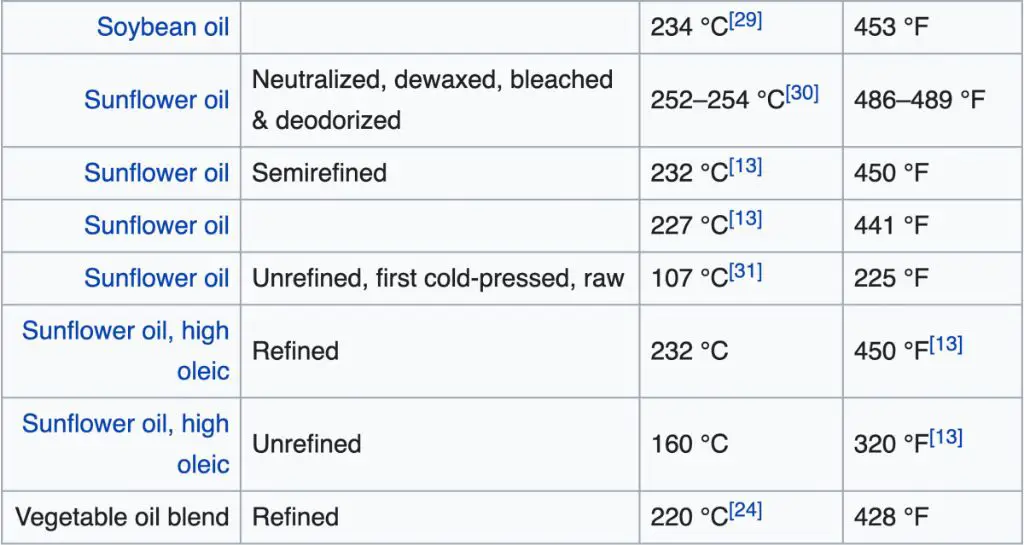What Oils Should I Buy?
Intro
There are many different types of cooking oils available, each with their own unique flavors, smoke points, and nutritional profiles. Choosing the right oil for cooking or baking can make a big difference in your finished dish.
In this article, we’ll provide an overview of some of the most common cooking oils, looking at their key characteristics, best uses, and potential health benefits and drawbacks. Understanding the differences between oils will help you select the right one for your needs.
Olive Oil
Olive oil is made by pressing whole olives and extracting the oil. It is one of the healthiest oils due to its high concentration of monounsaturated fatty acids, specifically oleic acid, which comprise 70-80% of olive oil (1). Oleic acid has been linked to several health benefits including reduced inflammation and lower risk of chronic diseases like heart disease (2).
Olive oil is rich in antioxidants like vitamins E and K that can fight inflammation and oxidative stress in the body. Studies show that replacing less healthy fats like butter with olive oil can lower LDL “bad” cholesterol and reduce heart disease risk (3). The FDA allows olive oil labels to contain a qualified health claim stating that olive oil may reduce heart disease risk when used instead of saturated fat (4).
Overall, olive oil is one of the healthiest oils to use regularly thanks to its high monounsaturated fat content and antioxidant properties. Replacing less healthy fats with olive oil has been shown to provide heart health benefits.
Sources:
(1) https://www.calforlife.com/calories/olive-oil-
(2) https://health.howstuffworks.com/wellness/food-nutrition/facts/olive-oil-nutrition-facts.htm
(3) https://oliveoillovers.com/blogs/our-journal/calories-in-olive-oil-nutrition-facts
(4) https://health.howstuffworks.com/wellness/food-nutrition/facts/olive-oil-nutrition-facts.htm

Coconut Oil
Coconut oil is made by extracting oil from raw coconuts or dried coconut meat (copra). It’s high in saturated fat, which was once dismissed as unhealthy, but has now been recognized as having unique health benefits when consumed in moderation as part of a balanced diet.
Coconut oil contains medium chain triglycerides (MCTs), which are metabolized differently than most fats. The potential health benefits of coconut oil come from its unique fatty acid profile.
About 90% of the fatty acids in coconut oil are saturated fat. These fats provide numerous potential health benefits like improved brain function, weight loss, reduced hunger, heart health, and improved cholesterol levels [1]. Coconut oil is very high in calories, providing about 116 calories per tablespoon. It does not contain any fiber, carbs, or protein [2].
Avocado Oil
Avocado oil is made by cold pressing the fruit of the avocado. It is high in heart-healthy monounsaturated fats, which may help lower cholesterol levels when eaten in place of saturated fats (1). Avocado oil also has a very high smoke point of 520°F, making it an excellent choice for high-heat cooking like sautéing, stir-frying and searing (2).
Some key health benefits of avocado oil include:
- Heart healthy – Rich in monounsaturated oleic acid which can help lower LDL (bad) cholesterol (3).
- High in antioxidants – Contains antioxidants like lutein and zeaxanthin that help protect eye health (4).
- May reduce inflammation – The oleic acid and antioxidants in avocado oil have anti-inflammatory properties (5).
- Good source of vitamin E – An essential antioxidant vitamin that plays a role in immune function and cell protection (6).
Avocado oil has a mild, nutty flavor that works well in salad dressings, dips and marinades. It can also be used for high-heat cooking methods. Look for cold pressed extra virgin avocado oil for maximum nutrition and flavor.
(1) https://latourangelle.com/blogs/general/6-benefits-of-virgin-avocado-oil
(2) https://zolacollective.com/blogs/blog/health-benefits-of-extra-virgin-avocado-oil
Vegetable Oil
Vegetable oil is a versatile cooking oil made from the seeds of plants such as soybeans, canola, corn, safflower, sunflower, etc.1 It is commonly used for baking, frying, sautéing, and as an ingredient in salad dressings, marinades and more. Vegetable oil is 100% fat and contains a mix of polyunsaturated and monounsaturated fats, with little to no saturated fat.2
The versatility and neutral flavor of vegetable oil make it a pantry staple for many home cooks. However, some sources raise concerns about overconsumption of omega-6 fatty acids from vegetable oils and potential negative health effects like inflammation.3 Using vegetable oil in moderation as part of a balanced diet is likely fine, but consider alternatives like olive or avocado oil for certain uses.
Butter
Butter is a dairy product made from churning the fat and protein components of cream. It has a rich, creamy flavor and smooth texture that makes it a popular cooking fat and spread. According to the source Markethouse.com (https://www.markethouse.com/blogs/the-sizzle/butter-vs-oil-how-should-you-cook-your-meat), butter imparts a delicious flavor to foods, especially proteins like meat, fish, and poultry. The milk solids in butter provide a sweet, nutty taste when melted or browned. However, butter has a relatively low smoke point of about 300-350°F, so it can burn quickly at high heat.
Because of its rich dairy flavor, butter is ideal for finishing sauces, spreading on breads, and enriching baked goods. However, for high-heat cooking like sautéing or frying, oils with higher smoke points are usually preferred over butter. When choosing a cooking fat, consider both the flavor you want to impart and the temperature you need to cook at.
Ghee
Ghee is a type of clarified butter that has been used in Indian and South Asian cooking for thousands of years. It is made by simmering butter and removing the milk solids and water. This process results in a clear, golden liquid with a rich nutty aroma and flavor. Ghee has a very high smoke point of about 485°F, which makes it ideal for cooking at high heat without burning (1).
Compared to regular butter, ghee contains little to no lactose or casein, the dairy proteins that some people have sensitivities to. The removal of the milk solids also allows ghee to be shelf-stable for up to a year when stored properly. It can be used for sautéing, roasting, frying, baking, and more, adding its signature nuttiness to dishes. When purchasing ghee, look for brands that source from grass-fed cows or are certified organic (2). Compared to vegetable oils, ghee provides certain nutrients like butyrate, vitamin K2, and conjugated linoleic acid (CLA) that benefit the body. Overall, its high smoke point and flavor make ghee a tasty alternative for cooking and baking.
(1) https://www.foodnetwork.com/fn-dish/news/2017/02/all-your-ghee-questions-answered
(2) https://www.healthline.com/health/food-nutrition/ghee-vs-butter
Grapeseed Oil
Grapeseed oil is made by pressing the seeds of grapes to extract the oil. It has become a popular oil choice due its high smoke point and mild flavor (1). Grapeseed oil contains high levels of polyphenols, antioxidant compounds that provide numerous health benefits. Research shows that the antioxidants in grapeseed oil can help protect the skin from sun damage and reduce inflammation (2).
One of the key benefits of grapeseed oil is its high smoke point of approximately 216°C or 421°F (1). This makes it suitable for high-heat cooking methods like frying, since the oil is less likely to oxidize and generate free radicals when heated to high temperatures. The light color and neutral taste of grapeseed oil also makes it versatile for use in dressings, marinades, and sauces without impacting flavor.
Overall, grapeseed oil is prized in cooking for its high heat tolerance, and in skincare for its antioxidant content. However, grapeseed oil does have a high omega-6 fatty acid content, so it’s best used in moderation as part of a balanced diet.
(1) https://www.byrdie.com/grape-seed-oil-beauty
(2) https://www.100percentpure.com/blogs/feed/10-benefits-of-grapeseed-oil-for-skin
Peanut Oil
Peanut oil is made by pressing roasted peanuts. It has a high smoke point which makes it a good choice for frying foods (https://www.webmd.com/diet/peanut-oil-health-benefits). Peanut oil contains monounsaturated fats like oleic acid which are considered heart-healthy fats. Studies have found that diets including peanut oil can help lower LDL “bad” cholesterol and triglycerides (https://peanut-institute.com/download/materials/peanut-oil_2_1329095013.pdf).
The high smoke point of 450°F makes peanut oil an ideal choice for stir-frying and deep frying. Foods fried in peanut oil absorb less oil than other oils, resulting in lower fat content (https://www.medicinenet.com/is_peanut_oil_healthy_the_surprising_truth/article.htm). Peanut oil’s neutral flavor also allows the true flavor of foods to shine through when frying or sautéing.
Conclusion
The best oil for cooking depends on the specific dish, temperature, and your dietary preferences. Keep in mind these key points when deciding which oil to use:
- For high heat cooking like stir frying, use oils with a high smoke point such as avocado, refined peanut, refined canola or grapeseed. Avoid unrefined oils.
- For baking and sautéing at medium heat, olive and coconut oil are good options. Butter can also be used but has a lower smoke point.
- For salad dressings and low heat applications, use flavorful unrefined oils like extra virgin olive oil and toasted sesame oil.
- For cooking Asian dishes, peanut, sesame and rice bran oils will provide an authentic flavor.
- For the healthiest option, choose plant-based oils that are high in monounsaturated fats like olive and avocado oil.
Test out different oils in your cooking to find which ones you like the taste of best. Having two or three oils on hand will allow you to cook diverse dishes and match the oil to your needs.


